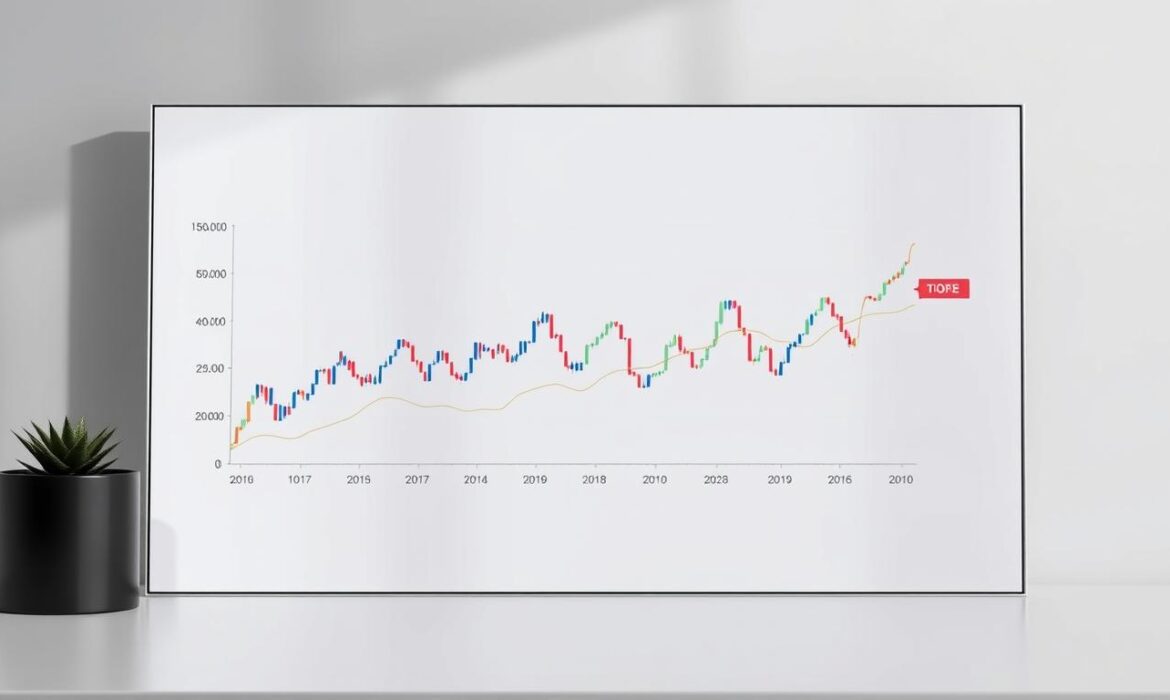Looking back at Singapore’s financial history reveals a clear pattern. Certain equities have consistently delivered strong results over time. These established companies form the backbone of many successful portfolios.
The Straits Times Index serves as the benchmark for top-tier Singaporean companies. These blue-chip selections have demonstrated remarkable resilience through various economic cycles. Their historical performance speaks volumes about their stability.
Many of these established companies offer attractive dividend yields. Recent TTM yields have ranged between 4.04% and 4.64%. This consistent income stream makes them particularly appealing for conservative investors.
Understanding market history helps investors make smarter choices today. By examining past performers, we can identify patterns that may repeat. This approach creates a solid foundation for building wealth over time.
This article explores specific companies that have stood the test of time. We’ll analyze their historical growth and income potential. Our goal is to help you build a portfolio based on proven performance data.
Key Takeaways
- Blue-chip stocks in Singapore have demonstrated consistent performance over many years
- The Straits Times Index contains the most established and reliable companies
- Historical dividend yields have provided attractive income for investors
- These investments have shown resilience during various economic conditions
- Past performance data can inform smarter investment decisions today
- Conservative investors often favor these stable, proven performers
- Understanding market history helps build stronger portfolios for the future
Introduction: Navigating Singapore’s Stock Market History
Singapore’s financial journey offers a fascinating story of growth and stability. The market has evolved from its early days into a sophisticated global hub. This transformation created exceptional opportunities for wealth building.
The Singapore Exchange (SGX) serves as the central marketplace for local equities. Established companies listed here have demonstrated remarkable consistency over decades. Their performance patterns provide valuable lessons for today’s investors.
Blue-chip selections represent the foundation of many successful portfolios. These enterprises maintain strong industry positions and established reputations. Their historical data reveals patterns of resilience during various economic conditions.
The Straits Times Index (STI) functions as the primary market barometer. It tracks the performance of top-tier companies across multiple sectors. This index helps investors gauge overall market health and direction.
“Historical market data provides the roadmap for future investment success. Patterns repeat, and lessons from the past inform smarter decisions today.”
Dividend income has consistently played a crucial role in total returns. Many established companies offer attractive yields that outperform fixed deposits. This income stream provides stability during market fluctuations.
Singapore’s political stability and business-friendly policies have supported market growth. The environment encourages long-term investment and wealth preservation. These factors contribute to the global recognition of local blue-chip companies.
Key advantages of studying market history include:
- Identifying reliable performance patterns across economic cycles
- Understanding dividend consistency and growth potential
- Recognizing sector strengths and diversification opportunities
- Learning from past market corrections and recovery patterns
Historical analysis helps investors develop effective long-term strategies. By examining past revenue trends and price movements, we gain valuable insights. This knowledge informs smarter allocation decisions for future growth.
Many investors find that blue-chip stocks represent some of the most reliable available. Their established track records provide confidence during uncertain market periods. This stability makes them particularly appealing for conservative portfolios.
The coming sections will explore specific companies and diversification approaches. We’ll examine how historical performance informs future investment strategies. This foundation helps build portfolios designed for long-term success.
What Are Blue-Chip Stocks and Why They Matter
Investors seeking stability often turn to well-established corporations that have demonstrated resilience across market cycles. These quality investments form the bedrock of many successful financial strategies.
Defining Blue-Chip Characteristics
Blue-chip companies represent the cream of the crop in the investment world. They typically feature substantial market capitalization and enjoy strong industry reputations.
These enterprises earn their status through consistent performance and leadership positions. Their track records show reliable earnings generation across various economic conditions.
Regular dividend distributions serve as a hallmark of these quality investments. This income stream provides stability during market fluctuations. Many investors appreciate this predictable return on their assets.

During economic downturns, these established companies typically show remarkable resilience. Their strong financial foundations help them weather challenging markets. This durability makes them attractive for conservative investment approaches.
Key attributes of these premium investments include:
- Large market capitalization indicating significant company size
- Strong industry reputation built over many years
- Consistent dividend payments providing regular income
- Proven ability to withstand economic challenges
- Leadership positions within their respective sectors
Singapore’s Straits Times Index Framework
The Straits Times Index serves as Singapore’s premier market benchmark. It tracks the largest and most liquid companies listed on the local exchange.
Inclusion criteria focus on market capitalization and trading liquidity. This ensures the index represents truly substantial enterprises. The selection process maintains high standards for quality representation.
The STI provides excellent sector diversification for investors. It includes companies from banking, telecommunications, real estate, and other industries. This broad exposure helps spread risk across different economic segments.
For local investors, the index offers a trusted guide to quality investments. It simplifies the process of identifying established companies with strong fundamentals. Many use it as a foundation for building their investment portfolio.
The STI framework helps investors:
- Identify top-tier companies meeting strict criteria
- Gain diversified exposure across multiple sectors
- Track overall market performance through a single indicator
- Make informed decisions based on established benchmarks
- Build confidence through investment in proven performers
Understanding this framework helps investors make smarter allocation decisions. It provides a solid foundation for long-term wealth building strategies. The index represents some of the most reliable opportunities available in local markets.
Why Blue-Chip Stocks Belong in Every Singapore Portfolio
Building a solid investment foundation requires choosing assets with proven track records. These established companies offer multiple advantages that benefit long-term wealth creation.
Their consistent performance makes them essential components for financial security. Let’s explore why these quality investments deserve a place in your strategy.
Proven Stability Through Market Cycles
Established companies demonstrate remarkable resilience during economic fluctuations. Their strong financial foundations help maintain steady revenue streams.
Many Singaporean blue-chips have weathered multiple global crises successfully. Their ability to adapt shows true business strength.
During the 2008 financial crisis, local banking giants maintained operations. They continued serving customers while managing risk effectively.
These companies often maintain substantial cash reserves for challenging times. This financial cushion helps them manage unexpected costs.

Consistent Dividend Income Streams
Regular dividend payments provide attractive income for investors. Many established companies offer reliable yield that outperforms savings accounts.
This passive income stream enhances total returns over time. Reinvesting dividends accelerates wealth accumulation significantly.
Singapore telecommunications companies have maintained dividend payments for decades. Their consistent distributions demonstrate financial discipline.
“Dividend income provides stability during market volatility, creating a reliable return component that complements capital appreciation.”
Real estate investment trusts offer another income source. Their mandatory distribution policies benefit income-focused investors.
Diversification Across Sectors
Blue-chip investments span multiple economic sectors for balanced exposure. This variety reduces concentration risk in your portfolio.
The Straits Times Index includes banking, telecommunications, and real estate companies. Each sector responds differently to economic conditions.
Banking operations thrive during economic expansion periods. Telecommunications services maintain stability during various market environments.
Real estate investments often benefit from inflation protection. This sector diversification smooths overall portfolio performance.
| Sector | Key Characteristics | Historical Performance |
|---|---|---|
| Banking | Interest income, economic sensitivity | Strong growth during expansion periods |
| Telecommunications | Recurring revenue, essential services | Stable through various market conditions |
| Real Estate | Property assets, rental income | Inflation protection, steady appreciation |
| Consumer Goods | Consumer demand, brand loyalty | Consistent through economic cycles |
Many established companies maintain international presence across multiple countries. This global exposure provides additional diversification benefits.
Singaporean banks operate throughout Southeast Asia successfully. Their regional business expands growth opportunities beyond local markets.
Telecommunications companies partner with international providers globally. These connections enhance service quality and revenue potential.
For investors seeking reliable income with growth potential, established dividend-paying companies represent excellent choices. Their balanced approach suits long-term wealth building strategies.
Historical Performance of Singapore’s Best Stocks
Examining long-term market data reveals compelling patterns among top-tier equities. These established companies have demonstrated remarkable consistency across decades.
The Straits Times Index serves as an excellent benchmark for historical analysis. It tracks the largest and most liquid companies on the local exchange.
Total returns combine capital appreciation with dividend distributions. This dual approach creates powerful wealth-building potential over time.
Market data through October 2025 shows impressive income generation. Real estate investment trusts like CapitaLand Integrated Commercial Trust achieved yields reaching 7.56%.
These returns significantly outperform traditional fixed deposits. They provide meaningful income during various market conditions.
Key historical performance metrics include:
- Consistent dividend growth across multiple economic cycles
- Capital appreciation during market expansion periods
- Resilience during economic downturns and recoveries
- Sector diversification benefits enhancing overall stability
Banking institutions have shown particular strength over time. Their net profit growth reflects Singapore’s economic development.
Telecommunications companies maintained steady performance through technology shifts. Their essential service nature provides reliable revenue streams.
Real estate investments demonstrated impressive inflation protection. Property values and rental income grew consistently over decades.
“Past performance doesn’t guarantee future results, but it provides valuable context for investment decisions. Historical patterns help investors understand potential risk and reward scenarios.”
Reinvested dividends significantly enhance total returns through compounding. This strategy turns income into additional growth opportunities.
Strategic management decisions played crucial roles in long-term success. Company leaders navigated economic challenges effectively.
Their decisions during the 2008 financial crisis demonstrated remarkable foresight. Strong capital preservation helped companies emerge stronger.
Historical data guides current investment approaches by:
- Identifying companies with consistent revenue generation
- Highlighting sectors with strong historical fundamentals
- Demonstrating the power of dividend reinvestment strategies
- Showing recovery patterns after market corrections
This information helps investors build confidence in their allocation choices. Understanding past performance creates a foundation for future expectations.
DBS Group Holdings: Singapore’s Banking Leader
Among Singapore’s financial giants, DBS Group Holdings stands out with remarkable consistency and performance. The institution has built an impressive track record that makes it a compelling choice for investors seeking stability and returns.

Record Financial Performance and Growth
DBS achieved outstanding results in 2024 with a net profit of S$11.4 billion. This represented an 11% increase from the previous year, demonstrating strong momentum.
The bank’s return on equity reached 18.0%, among the highest in the banking sector globally. This metric reflects excellent capital allocation and operational efficiency.
Net interest income grew significantly due to favorable interest rate conditions. Fee income also expanded across multiple business segments, contributing to overall revenue growth.
Wealth Management Dominance
DBS’s wealth management division reached S$396 billion in assets under management. The segment has become a major growth driver for the institution.
Fee income from wealth services surged as more clients sought professional management. The bank targets S$500 billion in AUM by 2026, showing confidence in continued expansion.
Singapore’s position as a wealth hub gives DBS natural advantages in attracting regional clients. The bank’s reputation for excellence draws substantial inflows from across Asia.
“Our wealth management business continues to exceed expectations, driven by strong client relationships and innovative solutions.”
Digital Innovation and Future Outlook
DBS has invested heavily in digital transformation initiatives across all operations. The bank’s mobile banking platform consistently ranks among the world’s best.
Digital services have improved customer experience while reducing operational costs. This innovation positions DBS well for future competition in the financial sector.
Management projects continued growth across all major business segments. Strategic focus remains on wealth management, digital banking, and regional expansion.
| Performance Metric | 2024 Result | Year-over-Year Change | Industry Benchmark |
|---|---|---|---|
| Net Profit | S$11.4 billion | +11% | Above Average |
| Return on Equity | 18.0% | +1.2 points | Top Quartile |
| Wealth Management AUM | S$396 billion | +15% | Market Leader |
| Net Interest Margin | 2.15% | +0.10 points | Strong Performance |
Dividend payments increased to S$2.22 per share, plus additional capital return initiatives. This shareholder-friendly approach enhances total returns for investors.
The bank has demonstrated resilience during market volatility and geopolitical tensions. Strong capital ratios and risk management practices provide stability during uncertain periods.
DBS remains a top choice for Singapore investors seeking quality exposure to the financial sector. The combination of growth potential, reliable income, and innovation makes it stand out among local options.
OCBC: Steady Growth and Reliable Returns
Oversea-Chinese Banking Corporation represents another pillar of Singapore’s financial landscape. The institution has built an impressive reputation for consistency and strategic growth.
OCBC’s approach combines traditional banking strength with modern wealth management services. This balanced strategy has delivered excellent results for shareholders over time.

Diversified Business Model Strengths
OCBC operates across multiple financial segments including banking, insurance, and wealth management. This diversification provides stability during various market conditions.
The bank’s insurance arm, Great Eastern Holdings, contributes significantly to overall revenue. This subsidiary represents one of Southeast Asia’s oldest and largest insurance companies.
Commercial banking services form the core of OCBC’s operations. The institution serves both corporate and individual clients across the region.
Wealth Management Expansion
OCBC’s wealth management division reached S$299 billion in assets under management. This represents substantial growth in the high-net-worth client segment.
Fee income from wealth services has increased steadily over recent years. The bank continues expanding its private banking capabilities across Asia.
Strong relationships with affluent clients drive recurring revenue streams. These services complement traditional banking operations effectively.
“Our wealth management business demonstrates excellent momentum, supported by strong client acquisition and deepening relationships across the region.”
Shareholder-Friendly Dividend Policy
OCBC maintains a consistent dividend policy that rewards long-term investors. The bank distributed S$1.01 per share in dividends during 2024.
This income stream provides attractive returns for income-focused investors. The dividend yield compares favorably with other fixed-income options.
Additionally, OCBC announced a S$2.5 billion capital return plan. This initiative demonstrates management’s commitment to shareholder value creation.
| Performance Metric | 2024 Result | Year-over-Year Change | Strategic Importance |
|---|---|---|---|
| Net Profit | S$7.59 billion | +8% | Record Performance |
| Wealth Management AUM | S$299 billion | +12% | Growth Driver |
| Net Interest Margin | 2.05% | +0.08 points | Core Profitability |
| Non-Performing Loans Ratio | 1.0% | Stable | Risk Management |
| Cost-to-Income Ratio | 42% | -1.5 points | Operational Efficiency |
OCBC’s regional presence across Southeast Asia and Greater China supports continued growth. The bank operates in 19 countries and territories worldwide.
This geographic diversification provides exposure to multiple growing economies. It also reduces dependence on any single market’s performance.
The institution maintains excellent asset quality with stable non-performing loan ratios. Conservative risk management practices protect during economic uncertainty.
Cost control measures have improved operational efficiency significantly. The cost-to-income ratio decreased to 42%, demonstrating effective management.
For investors seeking reliable income with growth potential, OCBC represents an excellent choice. Its combination of dividend income and capital appreciation makes it attractive for long-term wealth building.
The bank’s consistent performance and shareholder-friendly policies make it a cornerstone holding for many portfolios. Its established track record provides confidence during various market conditions.
UOB: Regional Presence and Consistent Performance
United Overseas Bank stands as a cornerstone of Southeast Asian banking with impressive stability. The institution combines traditional banking excellence with modern financial services. This approach has delivered reliable results for investors across market cycles.
Southeast Asian Market Penetration
UOB maintains a strong presence across multiple Southeast Asian countries. The bank operates in Malaysia, Thailand, Indonesia, and Vietnam successfully. This regional diversification provides valuable exposure to growing economies.
The integration of Citigroup’s consumer banking operations strengthened UOB’s position. This strategic acquisition expanded the bank’s customer base significantly. It enhanced their retail banking capabilities across the region.
UOB’s network spans more than 500 offices across 19 countries. This extensive reach supports cross-border banking services effectively. The bank serves both corporate and individual clients throughout Southeast Asia.
“Our ASEAN focus provides natural resilience and growth opportunities. The region’s economic fundamentals remain strong despite global challenges.”
Wealth Management Growth Trajectory
UOB’s wealth management division reached S$190 billion in assets under management. This represents impressive growth in serving affluent clients across the region. Fee income from wealth services increased substantially.
The bank’s wealth solutions include investment products and portfolio management services. These offerings cater to high-net-worth individuals and families. Digital platforms enhance accessibility and customer experience.
Wealth management contributes significantly to non-interest income. This diversification strengthens overall revenue stability. The segment shows continued potential for expansion.
Capital Return Initiatives
UOB distributed S$1.80 per share in dividends during 2024. This attractive income stream provides reliable returns for shareholders. The dividend yield compares favorably with other income options.
The bank announced a S$3 billion capital return package for investors. This initiative includes special dividends and share buyback programs. These actions demonstrate commitment to shareholder value creation.
Strong capital ratios support these shareholder-friendly policies. UOB maintains robust financial health while rewarding investors. This balanced approach benefits long-term wealth building.
| Performance Metric | 2024 Result | Strategic Significance |
|---|---|---|
| Net Profit | S$6.0 billion | Record Earnings Achievement |
| Wealth Management AUM | S$190 billion | Growing Fee Income Source |
| Net Interest Margin | 2.10% | Core Banking Profitability |
| Loan Growth | +7% Year-over-Year | Business Expansion Indicator |
| Digital Banking Users | +15% Growth | Modernization Progress |
UOB’s digital capabilities enhance customer solutions across all segments. Mobile banking adoption continues growing among consumer clients. These technological improvements support operational efficiency.
Asset quality remains strong with conservative risk management practices. The bank maintains low non-performing loan ratios. This discipline protects during economic uncertainty.
The institution represents an excellent choice for regional exposure and consistent returns. Its established track record provides confidence for long-term investors. UOB continues demonstrating why it belongs among top financial institutions.
Singtel: Telecommunications Giant with Digital Future
Singapore’s telecommunications landscape features a dominant player with impressive transformation capabilities. Singtel has evolved beyond traditional services into a comprehensive digital solutions provider. This strategic shift positions the company for sustained growth in the digital economy.
ST28 Strategy and Growth Initiatives
Singtel’s ST28 strategy focuses on three core growth engines: 5G deployment, data center expansion, and enhanced connectivity solutions. This comprehensive approach addresses evolving digital infrastructure needs across the region.
The company’s net profit surged 183% in Q3 FY2025, demonstrating strategic execution effectiveness. Underlying profit increased 11%, showing sustainable operational improvement.
Growth initiatives span across Optus, Singtel Singapore, and NCS divisions. Each segment contributes unique strengths to the overall growth strategy. Their combined efforts drive consistent revenue generation.
Operational efficiency improvements have significantly reduced operational costs. These savings enhance profitability while maintaining service quality. The company’s financial strength supports continued investment in growth areas.
Digital Infrastructure Expansion
Digital InfraCo expansion targets 155MW capacity through strategic projects. Nxera data center developments represent key components of this infrastructure push. These facilities support growing cloud computing and AI demand.
Green loan initiatives fund environmentally sustainable data center projects. This approach aligns with global sustainability trends while managing financial risk. The company maintains strong cash flow to support these investments.
Spectrum deployment achievements enhance 5G network capabilities nationwide. These technological advancements provide competitive advantages in telecommunications sectors. Singtel’s infrastructure investments create long-term value for shareholders.
“Our digital infrastructure expansion represents a cornerstone of future growth. These investments position us to capture opportunities in the evolving digital economy.”
Regional Associate Contributions
Regional associates including Airtel, AIS, and Globe contribute significantly to overall performance. Their growth in respective markets enhances Singtel’s diversified revenue streams. This geographic spread reduces dependence on any single market.
Associate contributions demonstrate resilience across diverse economic conditions. Their combined strong performance supports Singtel’s overall financial results. This diversified approach manages regional economic risk effectively.
Capital recycling targets aim to optimize investment returns across the portfolio. This strategy ensures efficient allocation of financial resources. It enhances shareholder value through strategic asset management.
Singtel’s dividend policy includes core and value realization components. The attractive dividend yield provides reliable income for investors. This distribution approach rewards shareholders while funding growth initiatives.
The company’s inclusion in the Straits Times Index reflects its market leadership position. This benchmark recognition underscores its importance among Singapore’s blue-chip companies. Investors value this established market position.
Singtel demonstrates how traditional companies can successfully transform for digital opportunities. Its balanced approach combines income generation with growth potential. This makes it an attractive choice for diversified portfolios seeking technology exposure.
Beyond Individual Stocks: Diversification Strategies
Smart investing goes beyond picking individual companies. A well-rounded approach combines different asset types for better results. This strategy helps manage risk while pursuing consistent returns.
Diversification spreads your investments across various categories. It reduces the impact of any single investment’s poor performance. This approach creates a more stable portfolio over time.
Combining Blue-Chips with ETFs and REITs
Exchange-traded funds offer instant diversification across multiple companies. They track indexes like the Straits Times Index with a single purchase. This provides broad market exposure without selecting individual stocks.
Real estate investment trusts add property exposure to your portfolio. They generate regular income through rental payments and property appreciation. REITs must distribute most of their taxable income to shareholders.
Combining these with established companies creates a balanced approach. You get stability from blue-chips plus diversification from other assets. This mix enhances portfolio resilience during market fluctuations.
Regular Savings Plans for Gradual Investing
Regular savings plans make investing accessible for everyone. They allow small, consistent investments over time. This approach reduces the impact of market timing on your returns.
OCBC’s Blue Chip Investment Plan requires a minimum monthly investment of S$100. POEMS Share Builders Plan starts at just S$50 per month. These low barriers help beginners start their investment journey.
Dollar-cost averaging happens automatically with these plans. You buy more shares when prices are low and fewer when high. This disciplined approach smooths out purchase prices over time.
“Regular investing turns market volatility into an advantage rather than a risk. Small consistent investments grow significantly through compounding over years.”
Sector Allocation Best Practices
Proper sector distribution balances risk and reward effectively. Different industries perform well during various economic conditions. Spreading investments helps capture growth while reducing volatility.
A balanced approach might include financial services, technology, and real estate. Each sector responds differently to economic changes. This diversity protects your portfolio during sector-specific downturns.
Review your sector allocation regularly to maintain balance. Market movements can change your original percentage allocations. Rebalancing brings your portfolio back to target weights.
| Asset Type | Allocation Range | Primary Benefit | Consideration |
|---|---|---|---|
| Blue-Chip Stocks | 40-60% | Stability & Dividends | Established track record |
| ETFs | 20-30% | Broad Diversification | Low management fees |
| REITs | 15-25% | Income & Inflation Hedge | Interest rate sensitive |
| Cash Reserves | 5-10% | Opportunity Fund | Lower potential returns |
These strategies work together to create robust portfolios. They complement established company investments beautifully. The combination enhances long-term wealth building potential.
Singapore investors can implement these approaches easily through local brokers. Many platforms offer automated regular investment plans. This makes disciplined investing accessible to everyone.
Diversification doesn’t guarantee profits or prevent losses. But it remains a fundamental principle of sound investment management. It helps investors stay committed during various market conditions.
Conclusion: Building Wealth with Singapore’s Proven Performers
Singapore’s established companies provide a solid foundation for wealth creation. Their historical performance shows consistent returns through various economic cycles.
These quality investments offer reliable dividend income and capital appreciation. Diversification across different sectors enhances portfolio stability.
Regular investment plans help build positions gradually over time. This disciplined approach smooths out market volatility.
Consider consulting financial advisors to tailor strategies to your goals. Start building your portfolio with these proven performers today.



